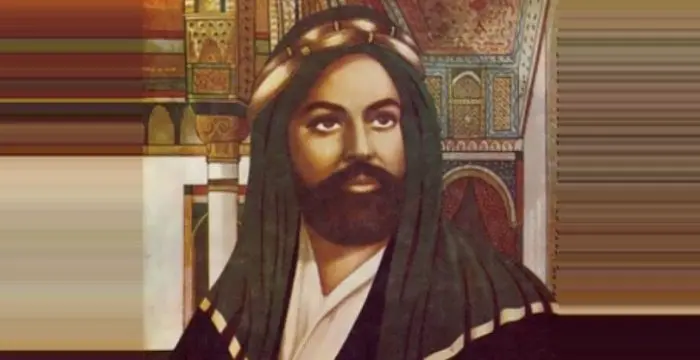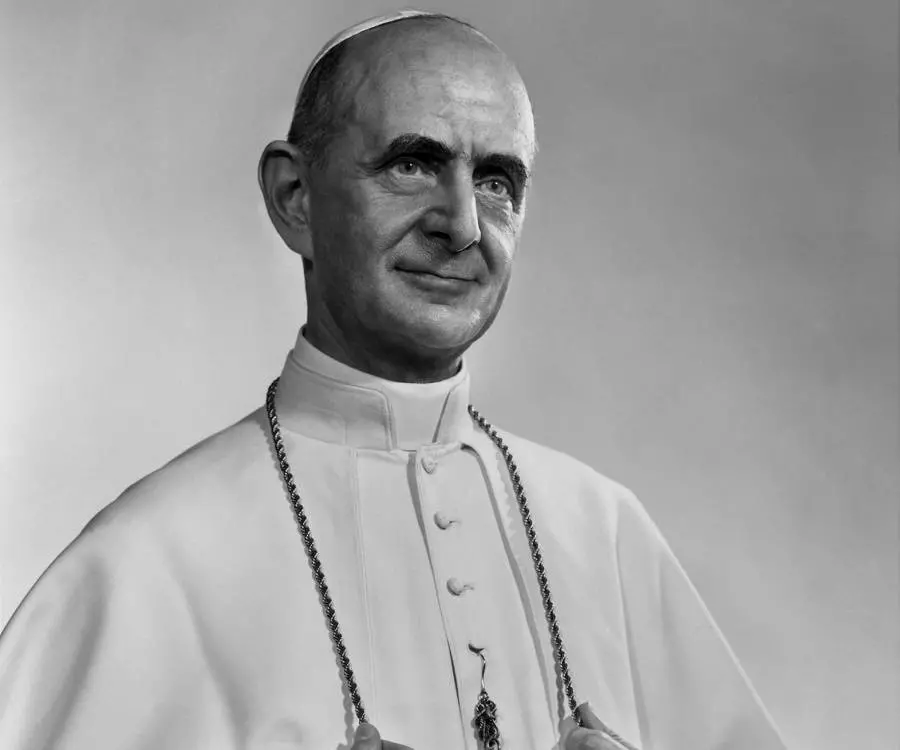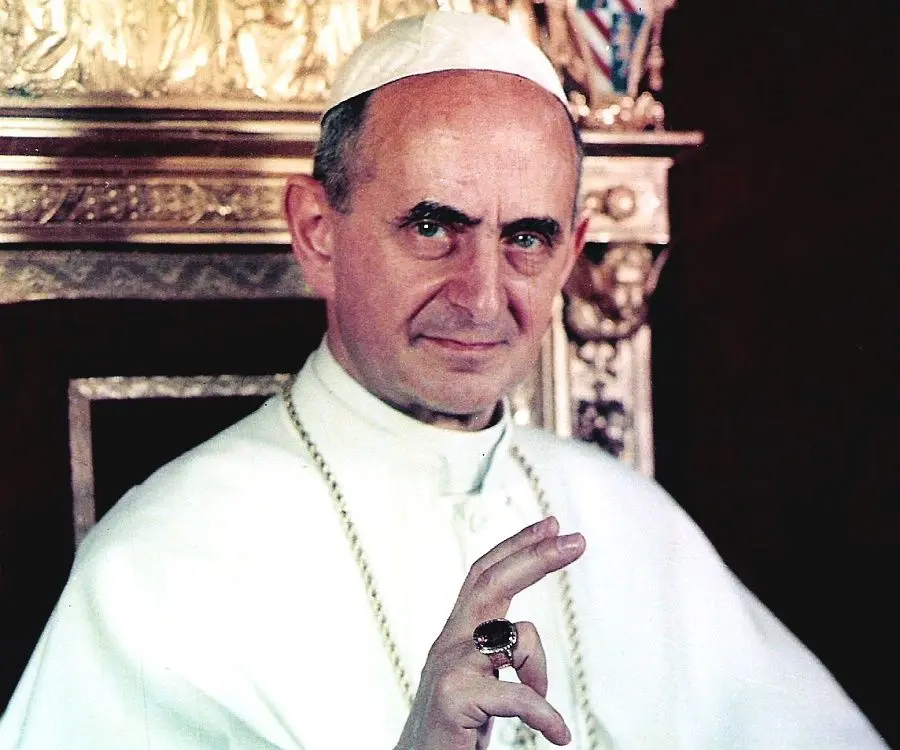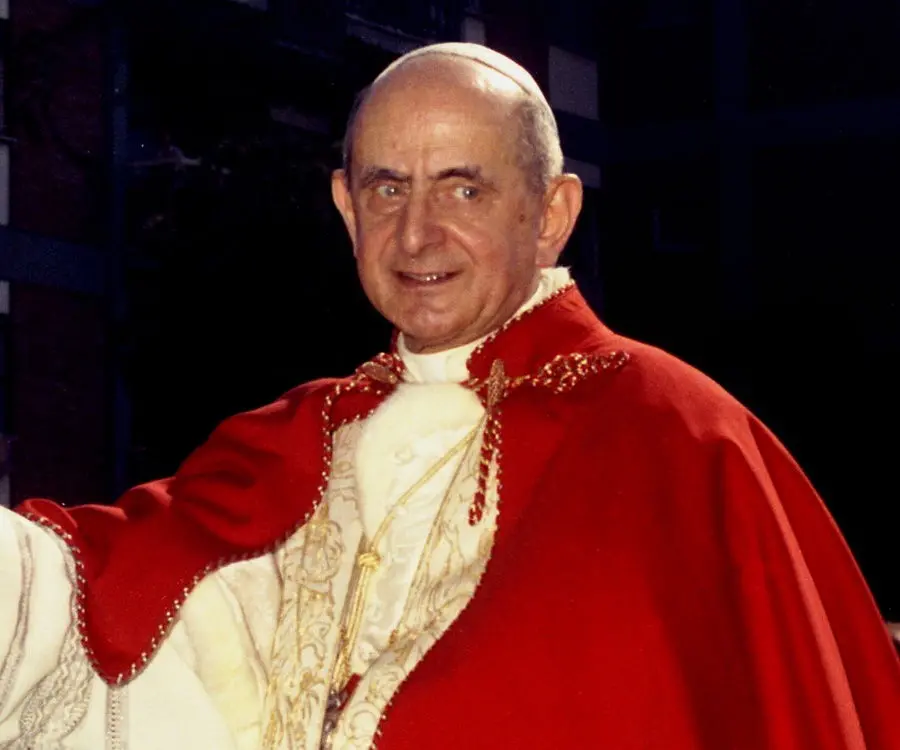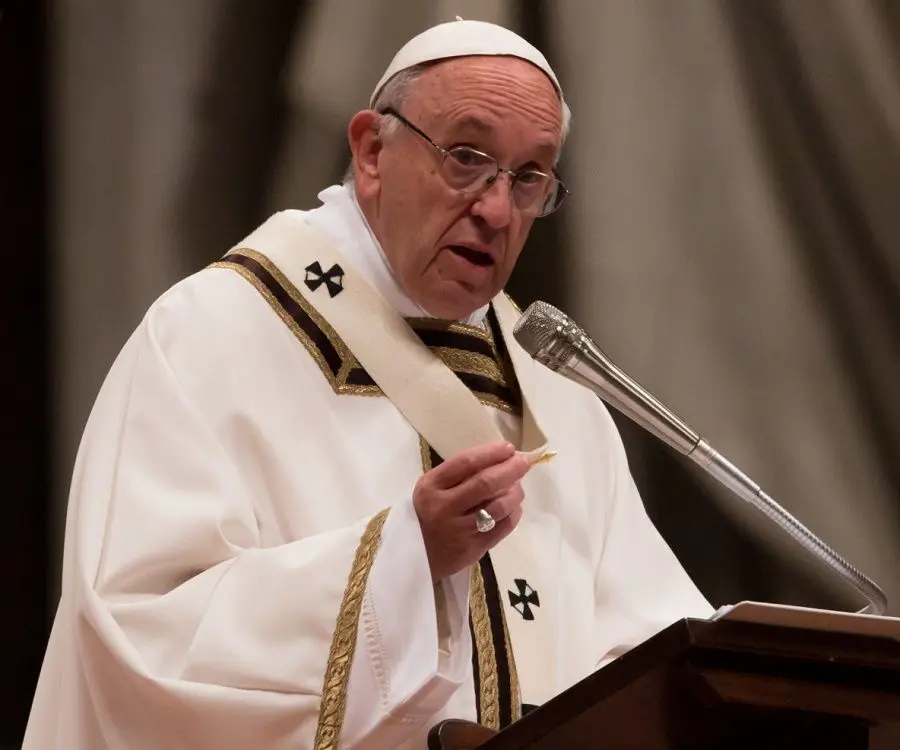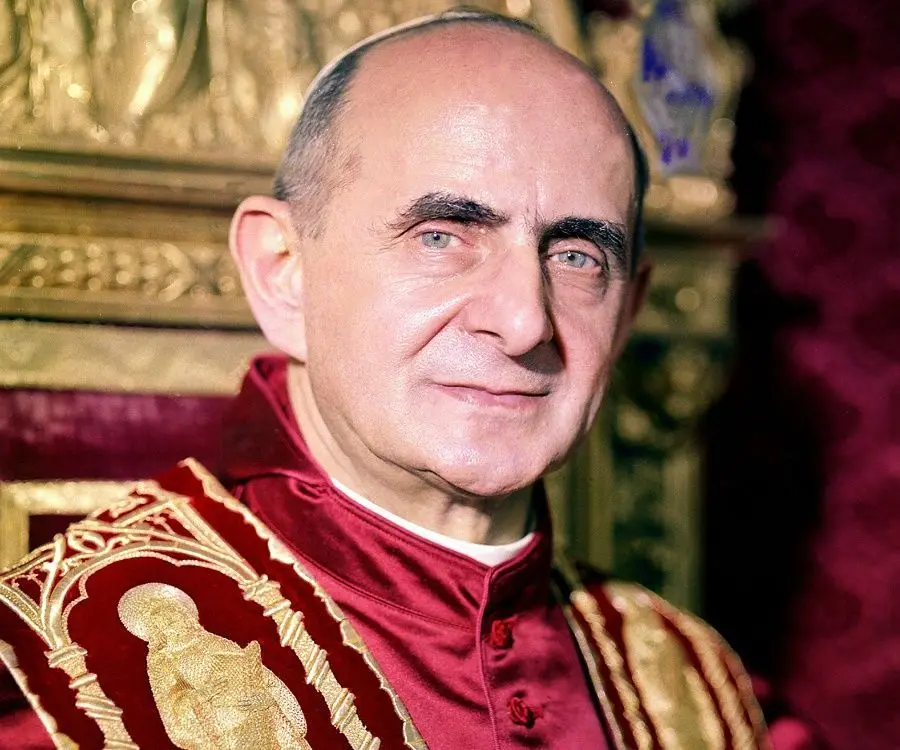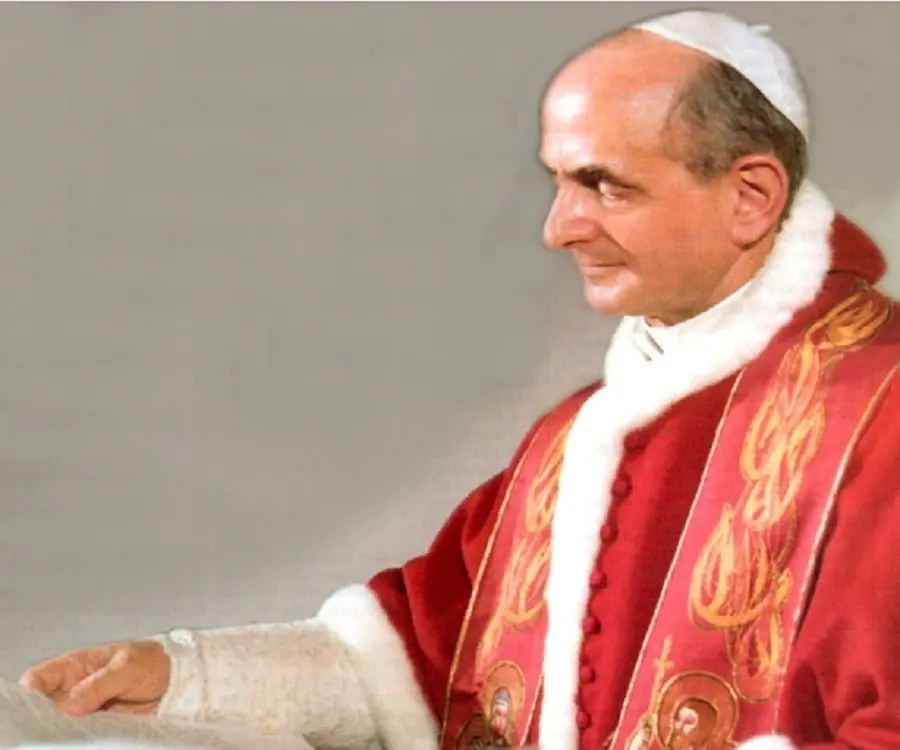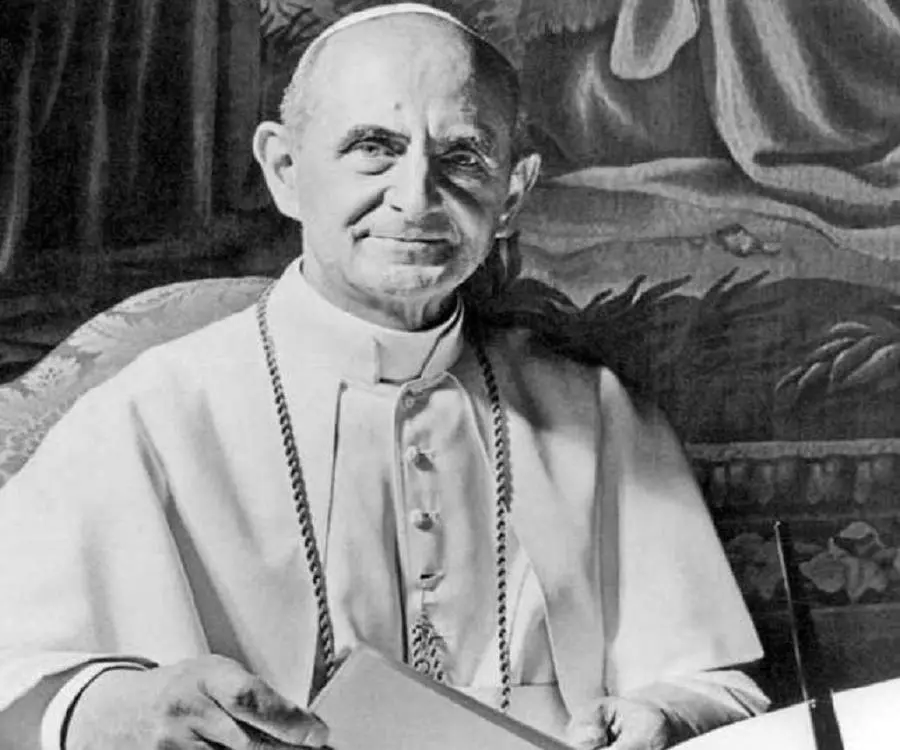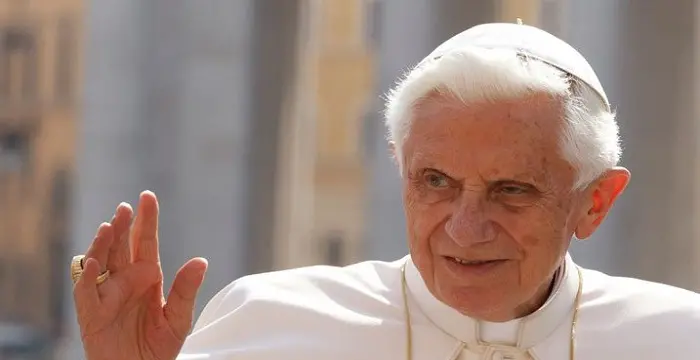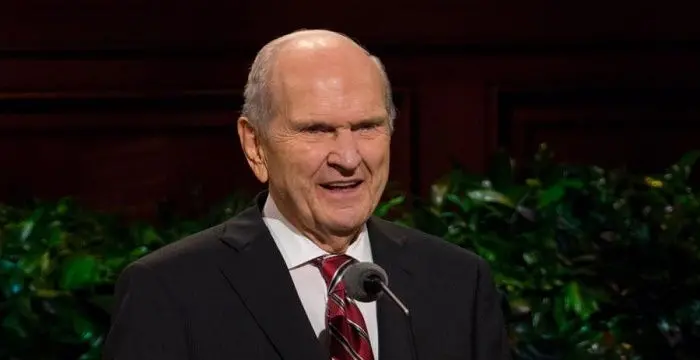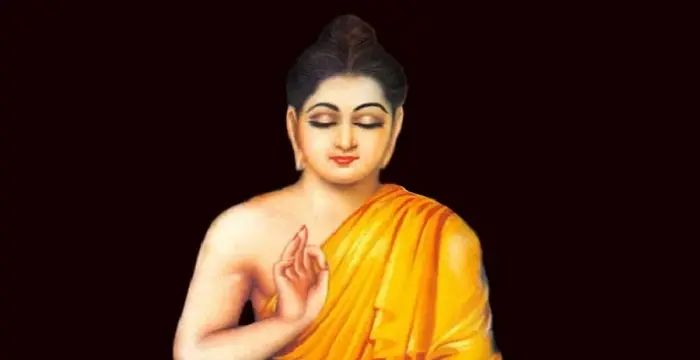
Pope Paul VI - Pope, Birthday and Facts
Pope Paul VI's Personal Details
Pope Paul VI was the pope from 21 June 1963 to 6 August 1978
| Information | Detail |
|---|---|
| Birthday | September 26, 1897 |
| Died on | August 6, 1978 |
| Nationality | Italian |
| Famous | Leaders, Spiritual & Religious Leaders, Pope, Religious Leaders, Spiritual |
| Siblings | Francesco Montini, Lodovico Montini |
| Known as | Giovanni Battista Enrico Antonio Maria Montini |
| Universities |
|
| Birth Place | Concesio |
| Religion | Roman Catholic Church |
| Height | 173 |
| Gender | Male |
| Father | Giorgio Montini |
| Mother | Giudetta Alghisi |
| Sun Sign | Libra |
| Born in | Concesio |
| Famous as | Pope |
| Died at Age | 80 |
// Famous Religious Leaders
Prophet Muhammad
Prophet Muhammad was the founder of Islam, one of the most widespread religions in the world. This biography profiles his childhood, life story, achievements and more.
Murad IV
Murad IV was one of the mighty Sultans in the history of the Ottoman Empire. This biography profiles his childhood, family, accession, rule, administration and timeline.
Eckhart Tolle
Eckhart Tolle is a well-known spiritual leader, and author. Check out this biography to know about his childhood, family, personal life, spiritual awakening, etc.
Pope Paul VI's photo
Who is Pope Paul VI?
Pope Paul VI (born as Giovanni Battista Enrico Antonio Maria Montini) was the pope who occupied the papal office after the passing of John XXIII. He was the pope from June 21, 1963, to his death, on August 6, 1978. He was raised in an affluent family and began his education at a Jesuit school. In 1916, at the age of 18 or 19, he joined the seminary to become a Catholic priest. Four years later, he was appointed a priest in Brescia. He received his doctorate in Canon Law later that year. After completing his education, Montini joined the Secretariat of State and later co-founded the publishing house Morcelliana in Brescia. He began his Vatican career in the diplomatic service of the Holy See. His administrative skills garnered him a thriving career in the Roman Curia. Following the death of Benedictine Cardinal Alfredo Ildefonso Schuster in 1954, Montini was appointed as the Archbishop of Milan. He was made Cardinal-Priest of Ss. Silvestro e Martino ai Monti by John XXIII in December 1958. His work during his time in the Catholic Church made him the likely successor of John XXIII. After he was elected, he continued the Second Vatican Council. He actively got involved in interpreting and implementing its directives. Paul VI ushered in unprecedented reforms that had positive effects on people from all walks of life. After his death, he has been recognised as a saint through the standard procedures.
// Famous Spiritual
Prophet Muhammad
Prophet Muhammad was the founder of Islam, one of the most widespread religions in the world. This biography profiles his childhood, life story, achievements and more.
Murad IV
Murad IV was one of the mighty Sultans in the history of the Ottoman Empire. This biography profiles his childhood, family, accession, rule, administration and timeline.
Eckhart Tolle
Eckhart Tolle is a well-known spiritual leader, and author. Check out this biography to know about his childhood, family, personal life, spiritual awakening, etc.
Childhood & Early Life
Montini was born on September 26, 1897, in Concesio, Brescia, Kingdom of Italy to Giorgio Montini and Giudetta Alghisi. Giorgio was a man of many talents. He was a journalist and lawyer. He also served as the director of the Catholic Action and a member of the Italian Parliament. Giudetta belonged to a family of rural nobility. They had two other sons, Francesco Montini, who went on to be a physician, and Lodovico Montini, who eventually worked as a lawyer and politician.
Montini was baptized a few days after he was born. He studied at the Cesare Arici School, a Jesuit institution. He was a sickly child and would often not be able to go to school due to bouts of illness. In 1916, he earned a diploma from the Arnaldo da Brescia public school in Brescia.
He soon enrolled at a seminary to be a Catholic priest. On May 29, 1920, he was appointed a priest in his hometown. He went on complete his doctorate in Canon Law in 1920 as well. He then attended the Gregorian University, the University of Rome La Sapienza, and Accademia dei Nobili Ecclesiastici.
Now that his education was completed, he chose to enter the Secretariat of State, where he worked under his long-time mentor Giuseppe Pizzardo. As a result, Montini never had to serve as a parish priest. In 1925, he helped set up the publishing house Morcelliana in his hometown, which concentrated on spreading a “Christian-inspired culture”.
Career at the Vatican
In 1923, Montini began his career in the Vatican as a secretary in the diplomatic service of the Holy See. He was stationed at the office of the papal nuncio in Poland, where he experienced the adverse components of nationalism. He would later state that his experience in the country was “useful, not always joyful”. After he assumed the papal office, he was refused entry into the country by the communist government.
Montini had already built a reputation for his organisational skills and it helped him when he switched to Roman Curia, the papal civil service. In 1931, Eugenio Pacelli, who would later become Pope Pius XII, installed him as a history teacher.
In 1937, he was picked as the Substitute for Ordinary Affairs, which allowed him the opportunity to work directly under Cardinal Pacelli, the Secretary of State. After Pacelli became the pope in 1939, he put Montini as Substitute under the new Cardinal Secretary of State, Luigi Maglione. Subsequently, he closely worked with the pope until 1954.
At the advent of the World War II, Montini emerged as one of the key figures in the Secretariat of State of the Holy See. Besides taking care of the “ordinary affairs” of the Secretariat of State, he also served as an unofficial personal secretary to the pope. During the war years, thousands of letters arrived in the Vatican from around the world and Montini answered as many of them as he could.
The pope asked him to set up an information office regarding refugees and prisoners of war. Between 1939 and 1947, it got ten million enquires and 11 million replies were sent out. The government of Benito Mussolini was a long-time critic of Montini for what it considered political meddling but the Holy See remained firm in its support of him. In 1944, he was appointed the joint Secretary of State along with Domenico Tardini.
Montini was an active Pro-Secretary of State (the title both he and Tardini received after their appointment). At the pope’s request, he co-founded Pontificia Commissione di Assistenza (Pontifical Commission for Assistance), a papal ad hoc commission that sought to distribute quick, non-bureaucratic and direct aid to needy refugees and prisoners in war-torn Europe. Montini also joined the initiative of the re-establishment of Church Asylum at the behest of the pope.
Archbishop of Milan
In 1954, after the passing of the Benedictine Cardinal Alfredo Ildefonso Schuster, Montini was made the Archbishop of Milan. His ascension to the position also made him the Secretary of the Italian Bishops Conference. On 5 January 1955, he officially assumed the ownership of the Cathedral of Milan.
In the first few months of his tenure, Montini reached out to the labour unions and associations, enquiring about the working conditions and labour issues. He deeply believed that in the contemporary society, churches were the only non-utilitarian buildings and that they were quintessential for spiritual rejuvenation. Subsequently, he ordered the construction of 100 new churches.
During his lifetime, most believed him to be a liberal. He requested people to love everyone, regardless of their religious identities. It was later revealed, by Pope Pius XII himself at the 1952 secret consistory, that neither Montini nor Tardini accepted designation to the cardinalate.
After the death of Pius XII, Angelo Roncalli assumed the papal office as Pope John XXIII. He appointed Montini to the cardinalate on December 15, 1958. Three years later, he was designated to the Central Preparatory Commission. At the pope’s request, Montini began living in Vatican City during this period. He served as a member of the Commission for Extraordinary Affairs but never participated in the floor debates.
Even before he became a cardinal, Montini was considered to be Pope John XXIII’s most likely successor by several of his peers. During his official African trip as a cardinal, he went to Ghana, Sudan, Kenya, Congo, Rhodesia, South Africa, and Nigeria and later met with the pope to tell him what he had seen. He also visited Brazil and the USA in 1960.
Papacy
Because of his personal relationships with both Pius XII and John XXIII, Montini was seen as the likely candidate for the papal office after the death of XXIII in June 1963. His pastoral and administrative background and the respect he had garnered during his career in the Church from both his subordinates and peers only affirmed the belief. Despite often being viewed as progressive, Montini was never known to harbour any radical political belief. He was neither left nor a right wing candidate.
On June 21, 1963, Montini was elected as the 262nd pope on the sixth ballot of the papal conclave. He adopted the name “Paul VI” in honour of Saint Paul. The white smoke was seen by the eager crowd waiting outside at 11:22 am. Paul VI appeared on central loggia after his election was announced, and chose to deliver a brief episcopal blessing as his first Apostolic Blessing over an elaborate and traditional Urbi et Orbi.
In his journal, the new pope recorded his thoughts on the papacy, “The position is unique. It brings great solitude. I was solitary before, but now my solitude becomes complete and awesome.”
Within two years of assuming the papal office, Paul VI’s physical health deteriorated so much that he wrote a letter to the dean of the College of Cardinals informing him of the issue and the possibility of not being able to function as the pope in future. Subsequently, he gave up his office as the Bishop of Rome and the head of the holy Roman Catholic Church.
As a council normally is abolished after the death of a pope, Paul VI’s decision to keep the Second Vatican Council active after his predecessor’s death drew criticism. He eventually led it to completion in 1965. Paul VI was seeking to categorically reform the Church, improve the relations with other Christian communities and other faiths, and open a dialogue with the world.
He claimed that “the most characteristic and ultimate purpose of the teachings of the Council" is the universal call to holiness. He went on elaborate that Christians of all ranks and status must adhere to the Christian life and “the perfection of charity, by this holiness as such a more human manner of living is promoted in this earthly society." The teaching was written down in Lumen Gentium, which was one of the principal documents of the council. A dogmatic constitution, it was promulgated by Paul VI on November 21, 1964.
Paul VI was the first pope in history to travel to six continents. It earned him the nickname, “the Pilgrim Pope”. In 1964, he made his pilgrimage to the Holy Land. He was also the first reigning pope to go to the western hemisphere, where he delivered a speech at the United Nations in New York City.
After former Italian Prime Minister Aldo Moro, was abducted by Red Brigades, an Italy-based terrorist organization, on March 16, 1978, Paul VI tried to intervene on Moro’s behalf by writing Red Brigades a letter. Moro was his friend from their FUCI student days, and they had supported each other throughout their respective careers. Eventually, on 9 May, Moro’s body was discovered in a car in Rome. It was riddled with several bullet wounds.
Major Works & Reforms
One of the biggest changes Pope Paul VI brought about in the Vatican was to do away with the regal splendour. His ascension to the papal office marked the last time a pope had been crowned as his successors underwent an inauguration for papal coronation. In 1978, he ended most of the ceremonial functions of the old Roman nobility at the court with the motu proprio Pontificalis Domus. He also disbanded the Palatine Guard and the Noble Guard, effectively making the Swiss Guard Vatican’s only military order.
He set up the Synod of Bishops on September 14, 1965 to serve as a permanent institution of the Church and an advisory body to the papacy. Throughout his tenure as the pope, he held several conferences with the Synod of Bishops on various issues.
Having previously worked in the Roman Curia, Paul VI knew all its shortcomings well. He brought about reforms in stages. First, he implemented a regulation that had been started by Pius XII and maintained by John XXIII, on March 1, 1968. He then began completely revamping the entire Curia over the course of the next few years by using several additional Apostolic Constitutions. He curtailed the size of the bureaucracy and brought in many non-Italians to serve in the curial positions.
Paul VI issued a request to all Catholic bishops on August 6, 1966, to proffer their resignation to the pontiff by their 75th birthday. On November 21, 1970, he also reached out to the cardinals asking them to submit theirs by their 80th birthday. Neither requirement was mandatory but was offered as a request. When he was asked why the same rule would not apply to him as well, he answered, “"Kings can abdicate, Popes cannot."
The concept of reforming customary public worship or liturgy had been part of liturgical movements in the 20th century in several European countries, including France and Germany. Under Pius XII, the Vatican made the use of vernacular languages possible during specific religious ceremonies, such as baptisms and funerals. In April 1969, Paul VI put his approval on the “new Order of Mass". While the Mass of Paul VI was performed in Latin, he approved the notion that vernacular languages could be used.
Personal Life, Death & Legacy
On November 27, 1970, during his visit to Manila, Philippines, Pope Paul VI was attacked by a crew-cut, cassock-clad man with a knife. Paul VI was accompanied by President Ferdinand Marcos and personal aide Pasquale Macchi and both of them stepped in to protect him. The attacker later turned out to be a 35-year-old artist named Benjamin Mendoza y Amor. A Bolivian expat, he was living in the Philippines at the time. The pope was unharmed and went on to complete his trip.
The Sacred Congregation for the Doctrine of the Faith put out a document titled ‘Persona Humana: Declaration on Certain Questions concerning Sexual Ethics’ on December 29, 1975, reiterating the Church’s stance on pre or extra-marital sex, homosexual activity, and masturbation being sinful. In response, Roger Peyrefitte, a French diplomat and gay rights activist, who had previously published two books where he mentioned that Paul VI was in a long-time homosexual relationship, restated those claims once more.
Peyrefitte dubbed Paul VI a hypocrite who had been in a relationship with an actor. There were speculations that the said actor was Paolo Carlini. The pope address the charges during his speech at St. Peters Square on April 18, 1976, claiming that they were, “horrible and slanderous insinuations" and requested the people to pray on his behalf.
Paul VI died of a heart attack on August 6, 1978, at Castel Gandolfo. He was laid to rest in the “true earth” in St. Peter's Basilica, as per the terms of his will. As a result, he was not buried in an ornate sarcophagus. His earthly tomb is covered by a simple travertine slab.
The process of the canonization of Pope Paul VI began on March 18, 1993 and is still on-going. He has been already proclaimed a “Servant of God” and hailed as “Venerable.” His beatification happened on October 19, 2014. On March 6, 2018, Pope Francis approved Paul VI’s canonization. The official ceremony is to take place on 14 October.
// Famous Pope
Pope John XXIII
Pope John XXIII, regarded as one of the most popular popes, was the head of the Catholic Church from 1958 to 1963. This biography of Pope John XXIII provides detailed information about his childhood, life, achievements, works & timeline.
Pope Benedict XVI
Pope Benedict XVI is a prominent religious figure as the Pope Emeritus. This biography profiles his childhood, life, resignation, achievements, and timeline.
Pope Paul VI's awards
| Year | Name | Award |
|---|---|---|
Other | ||
| 0 | Order of the Golden Spur | |
| 0 | Grand Cross of the Order of Isabella the Catholic | |
| 0 | Knight Grand Cross of the Order of Merit of the Italian Republic | |
| 0 | Order of St. Gregory the Great | |
| 0 | Order of Pius IX | |
Pope Paul VI biography timelines
- // 26th Sep 1897Montini was born on September 26, 1897, in Concesio, Brescia, Kingdom of Italy to Giorgio Montini and Giudetta Alghisi. Giorgio was a man of many talents. He was a journalist and lawyer. He also served as the director of the Catholic Action and a member of the Italian Parliament. Giudetta belonged to a family of rural nobility. They had two other sons, Francesco Montini, who went on to be a physician, and Lodovico Montini, who eventually worked as a lawyer and politician.
- // 1916Montini was baptized a few days after he was born. He studied at the Cesare Arici School, a Jesuit institution. He was a sickly child and would often not be able to go to school due to bouts of illness. In 1916, he earned a diploma from the Arnaldo da Brescia public school in Brescia.
- // 29th May 1920He soon enrolled at a seminary to be a Catholic priest. On May 29, 1920, he was appointed a priest in his hometown. He went on complete his doctorate in Canon Law in 1920 as well. He then attended the Gregorian University, the University of Rome La Sapienza, and Accademia dei Nobili Ecclesiastici.
- // 1923In 1923, Montini began his career in the Vatican as a secretary in the diplomatic service of the Holy See. He was stationed at the office of the papal nuncio in Poland, where he experienced the adverse components of nationalism. He would later state that his experience in the country was “useful, not always joyful”. After he assumed the papal office, he was refused entry into the country by the communist government.
- // 1925Now that his education was completed, he chose to enter the Secretariat of State, where he worked under his long-time mentor Giuseppe Pizzardo. As a result, Montini never had to serve as a parish priest. In 1925, he helped set up the publishing house Morcelliana in his hometown, which concentrated on spreading a “Christian-inspired culture”.
- // 1931Montini had already built a reputation for his organisational skills and it helped him when he switched to Roman Curia, the papal civil service. In 1931, Eugenio Pacelli, who would later become Pope Pius XII, installed him as a history teacher.
- // 1952During his lifetime, most believed him to be a liberal. He requested people to love everyone, regardless of their religious identities. It was later revealed, by Pope Pius XII himself at the 1952 secret consistory, that neither Montini nor Tardini accepted designation to the cardinalate.
- // 1954 To 5th Jan 1955In 1954, after the passing of the Benedictine Cardinal Alfredo Ildefonso Schuster, Montini was made the Archbishop of Milan. His ascension to the position also made him the Secretary of the Italian Bishops Conference. On 5 January 1955, he officially assumed the ownership of the Cathedral of Milan.
- // 15th Dec 1958After the death of Pius XII, Angelo Roncalli assumed the papal office as Pope John XXIII. He appointed Montini to the cardinalate on December 15, 1958. Three years later, he was designated to the Central Preparatory Commission. At the pope’s request, Montini began living in Vatican City during this period. He served as a member of the Commission for Extraordinary Affairs but never participated in the floor debates.
- // 1960Even before he became a cardinal, Montini was considered to be Pope John XXIII’s most likely successor by several of his peers. During his official African trip as a cardinal, he went to Ghana, Sudan, Kenya, Congo, Rhodesia, South Africa, and Nigeria and later met with the pope to tell him what he had seen. He also visited Brazil and the USA in 1960.
- // Jun 1963Because of his personal relationships with both Pius XII and John XXIII, Montini was seen as the likely candidate for the papal office after the death of XXIII in June 1963. His pastoral and administrative background and the respect he had garnered during his career in the Church from both his subordinates and peers only affirmed the belief. Despite often being viewed as progressive, Montini was never known to harbour any radical political belief. He was neither left nor a right wing candidate.
- // 21st Jun 1963On June 21, 1963, Montini was elected as the 262nd pope on the sixth ballot of the papal conclave. He adopted the name “Paul VI” in honour of Saint Paul. The white smoke was seen by the eager crowd waiting outside at 11:22 am. Paul VI appeared on central loggia after his election was announced, and chose to deliver a brief episcopal blessing as his first Apostolic Blessing over an elaborate and traditional Urbi et Orbi.
- // 1964Paul VI was the first pope in history to travel to six continents. It earned him the nickname, “the Pilgrim Pope”. In 1964, he made his pilgrimage to the Holy Land. He was also the first reigning pope to go to the western hemisphere, where he delivered a speech at the United Nations in New York City.
- // 21st Nov 1964He claimed that “the most characteristic and ultimate purpose of the teachings of the Council" is the universal call to holiness. He went on elaborate that Christians of all ranks and status must adhere to the Christian life and “the perfection of charity, by this holiness as such a more human manner of living is promoted in this earthly society." The teaching was written down in Lumen Gentium, which was one of the principal documents of the council. A dogmatic constitution, it was promulgated by Paul VI on November 21, 1964.
- // 1965As a council normally is abolished after the death of a pope, Paul VI’s decision to keep the Second Vatican Council active after his predecessor’s death drew criticism. He eventually led it to completion in 1965. Paul VI was seeking to categorically reform the Church, improve the relations with other Christian communities and other faiths, and open a dialogue with the world.
- // 14th Sep 1965He set up the Synod of Bishops on September 14, 1965 to serve as a permanent institution of the Church and an advisory body to the papacy. Throughout his tenure as the pope, he held several conferences with the Synod of Bishops on various issues.
- // 6th Aug 1966 To 21st Nov 1970Paul VI issued a request to all Catholic bishops on August 6, 1966, to proffer their resignation to the pontiff by their 75th birthday. On November 21, 1970, he also reached out to the cardinals asking them to submit theirs by their 80th birthday. Neither requirement was mandatory but was offered as a request. When he was asked why the same rule would not apply to him as well, he answered, “"Kings can abdicate, Popes cannot."
- // 1st Mar 1968Having previously worked in the Roman Curia, Paul VI knew all its shortcomings well. He brought about reforms in stages. First, he implemented a regulation that had been started by Pius XII and maintained by John XXIII, on March 1, 1968. He then began completely revamping the entire Curia over the course of the next few years by using several additional Apostolic Constitutions. He curtailed the size of the bureaucracy and brought in many non-Italians to serve in the curial positions.
- // Apr 1969The concept of reforming customary public worship or liturgy had been part of liturgical movements in the 20th century in several European countries, including France and Germany. Under Pius XII, the Vatican made the use of vernacular languages possible during specific religious ceremonies, such as baptisms and funerals. In April 1969, Paul VI put his approval on the “new Order of Mass". While the Mass of Paul VI was performed in Latin, he approved the notion that vernacular languages could be used.
- // 27th Nov 1970On November 27, 1970, during his visit to Manila, Philippines, Pope Paul VI was attacked by a crew-cut, cassock-clad man with a knife. Paul VI was accompanied by President Ferdinand Marcos and personal aide Pasquale Macchi and both of them stepped in to protect him. The attacker later turned out to be a 35-year-old artist named Benjamin Mendoza y Amor. A Bolivian expat, he was living in the Philippines at the time. The pope was unharmed and went on to complete his trip.
- // 29th Dec 1975The Sacred Congregation for the Doctrine of the Faith put out a document titled ‘Persona Humana: Declaration on Certain Questions concerning Sexual Ethics’ on December 29, 1975, reiterating the Church’s stance on pre or extra-marital sex, homosexual activity, and masturbation being sinful. In response, Roger Peyrefitte, a French diplomat and gay rights activist, who had previously published two books where he mentioned that Paul VI was in a long-time homosexual relationship, restated those claims once more.
- // 18th Apr 1976Peyrefitte dubbed Paul VI a hypocrite who had been in a relationship with an actor. There were speculations that the said actor was Paolo Carlini. The pope address the charges during his speech at St. Peters Square on April 18, 1976, claiming that they were, “horrible and slanderous insinuations" and requested the people to pray on his behalf.
- // 1978One of the biggest changes Pope Paul VI brought about in the Vatican was to do away with the regal splendour. His ascension to the papal office marked the last time a pope had been crowned as his successors underwent an inauguration for papal coronation. In 1978, he ended most of the ceremonial functions of the old Roman nobility at the court with the motu proprio Pontificalis Domus. He also disbanded the Palatine Guard and the Noble Guard, effectively making the Swiss Guard Vatican’s only military order.
- // 16th Mar 1978After former Italian Prime Minister Aldo Moro, was abducted by Red Brigades, an Italy-based terrorist organization, on March 16, 1978, Paul VI tried to intervene on Moro’s behalf by writing Red Brigades a letter. Moro was his friend from their FUCI student days, and they had supported each other throughout their respective careers. Eventually, on 9 May, Moro’s body was discovered in a car in Rome. It was riddled with several bullet wounds.
- // 6th Aug 1978Paul VI died of a heart attack on August 6, 1978, at Castel Gandolfo. He was laid to rest in the “true earth” in St. Peter's Basilica, as per the terms of his will. As a result, he was not buried in an ornate sarcophagus. His earthly tomb is covered by a simple travertine slab.
// Famous Spiritual & Religious Leaders
Swami Vivekananda
Swami Vivekananda was the chief disciple of Sri Ramakrishna, and was responsible for awakening India spiritually. Check this biography to know in detail about his life, profile and timeline.
Prophet Muhammad
Prophet Muhammad was the founder of Islam, one of the most widespread religions in the world. This biography profiles his childhood, life story, achievements and more.
Murad IV
Murad IV was one of the mighty Sultans in the history of the Ottoman Empire. This biography profiles his childhood, family, accession, rule, administration and timeline.
Eckhart Tolle
Eckhart Tolle is a well-known spiritual leader, and author. Check out this biography to know about his childhood, family, personal life, spiritual awakening, etc.
Russell M. Nelson
Russell M. Nelson is an American religious leader, author, and philanthropist. Check out this biography to know about his birthday, childhood, family life, achievements and fun facts about him.
Gautama Buddha
Gautama Buddha was a spiritual leader on whose teachings Buddhism was founded. This biography of Gautama Buddha provides detailed information about his childhood, life, achievements, works & timeline
Pope Paul VI's FAQ
What is Pope Paul VI birthday?
Pope Paul VI was born at 1897-09-26
When was Pope Paul VI died?
Pope Paul VI was died at 1978-08-06
Where was Pope Paul VI died?
Pope Paul VI was died in Castel Gandolfo
Which age was Pope Paul VI died?
Pope Paul VI was died at age 80
Where is Pope Paul VI's birth place?
Pope Paul VI was born in Concesio
What is Pope Paul VI nationalities?
Pope Paul VI's nationalities is Italian
Who is Pope Paul VI siblings?
Pope Paul VI's siblings is Francesco Montini, Lodovico Montini
What was Pope Paul VI universities?
Pope Paul VI studied at Pontifical Ecclesiastical Academy, Pontifical Gregorian University
What is Pope Paul VI's religion?
Pope Paul VI's religion is Roman Catholic Church
How tall is Pope Paul VI?
Pope Paul VI's height is 173
Who is Pope Paul VI's father?
Pope Paul VI's father is Giorgio Montini
Who is Pope Paul VI's mother?
Pope Paul VI's mother is Giudetta Alghisi
What is Pope Paul VI's sun sign?
Pope Paul VI is Libra
How famous is Pope Paul VI?
Pope Paul VI is famouse as Pope
